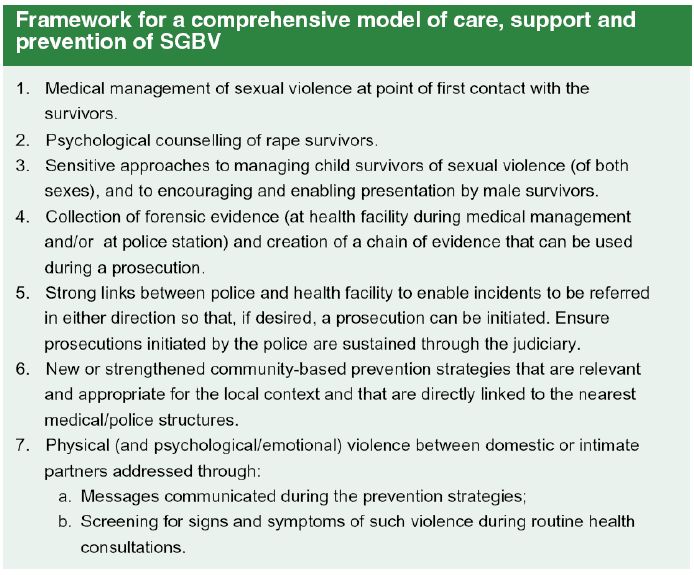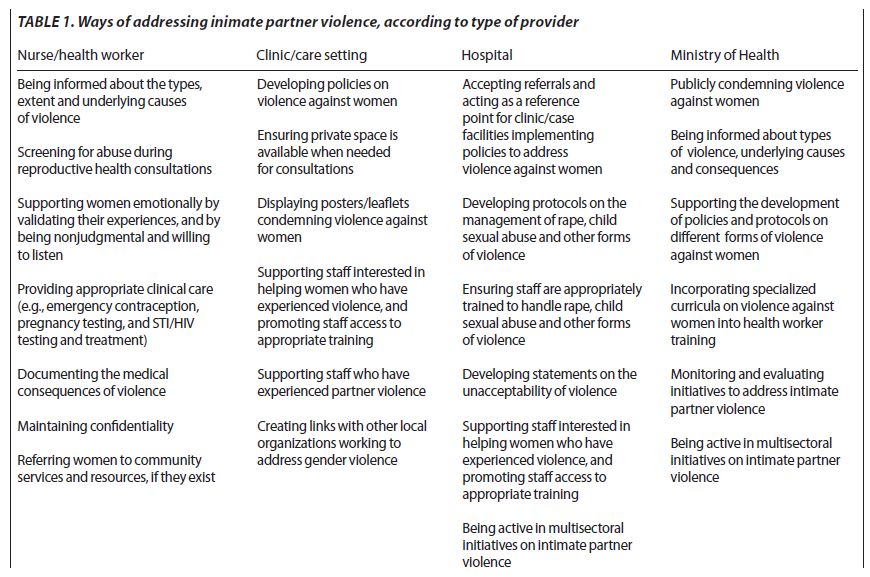- While a great deal of knowledge has been accumulated about key aspects of health programming to address violence against women, the relative lack of evaluations of programming efforts worldwide means that the evidence upon which to build a comprehensive health approach is still insufficient.
- Even so, there have been several evaluations—most of them small-scale—that focus on various aspects of health interventions (including primary prevention and better responses) to address violence against women. These evaluations include:
- IPPF/WHR Regional Initiative, Latin America
- PAHO/PATH, Latin America
- Stepping Stones, South Africa
- Radar/IMAGE, South Africa
- Minga Peru, Peru
- Queen Mary’s School of Medicine and Dentistry, United Kingdom
- Drawing from lessons learned through these and other programs, approaches to address violence against women and girls within the health sector should in general reflect and be situated within overarching strategies for ending violence against women and girls. Key elements of an overarching strategy are described in the Programming Essentials module, and include:
- Investing in gender equality and women’s empowerment, including changing gender norms and working with men and boys
- Developing and/or reforming legislation
- Ensuring holistic multisectoral policies and national plans of action
- Securing resources and budgets
- Promoting primary prevention (across different sectors)
- Strengthening key sectors
- Developing coordinated community responses
- Engaging key groups
- Capacity development
- Conducting research, data collection and analysis
- Monitoring and national accountability
- In addition to these overarching strategies, specific health-sector strategies include:
- Utilizing a system-wide approach in health facilities, including attention to the policies, protocols, infrastructure, supplies, staff capacity to deliver quality medical and psychosocial support, staff training and other professional development opportunities, case documentation and data systems, the functioning of referral networks, safety and danger assessments, among other items that are relevant to specific contexts and programmes.
- Advancing laws, policies and protocols to support comprehensive care to survivors and ensuring that health care providers understand the relevant laws, policies, and protocols
- Investing in equipment and supplies necessary for comprehensive care
- Ensuring quality response, for example through one-stop centres, integrated services within a facility or referrals to other health facilities and non-health services (e.g. police, social and legal support)
- Establishing standardized data collection and management systems within and across health facilities
- Institutionalizing health provider training
- Increasing availability of forensic exams, for example through nurse examiners
- Improving monitoring and evaluation for quality of care
- Providing community education about violence against women and availability of services
- Addressing the needs of specific populations, including adolescents, women and girls with disabilities, sex workers, indigenous populations or ethnic minorities, and HIV positive women, among others.
- It is also critical that the health sector understand specific responsibilities related to the type of violence being addressed.
- For example, the following framework proposes key aspects of a comprehensive approach to post-sexual violence services:

Excerpted from Population Council, 2008b. Sexual and Gender Based Violence in Africa: A Literature Review, pg. 2.
- For intimate partner violence, key actors within the health sector might have the responsibilities described below (organized by the levels in the health system, from individual providers up to the Ministry of Health):

Excerpted from Watts and Mayhew, 2004. "Reproductive Health Services and Intimate Partner Violence: Shaping a Pragmatic Response In Sub-Saharan Africa." International Family Planning Perspectives 30, no. 4, p. 210.
Additional Resources:
Gender-Based Violence, Health and the Role of the Health Sector (World Bank). Available in English.
“Addressing Gender-Based Violence: A Critical Review of Interventions”, The World Bank Observer. 2007; 22: 25-51 (Morrison, A., Ellsberg, M. and Bott, S., 2007). Available in English.
“Tackling Domestic Violence: Effective Approaches and Interventions”, Home Office Research Study, no. 290, Home Office, London (Hester, M., and Westmarland, N., 2005). Available in English.
